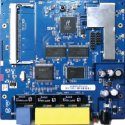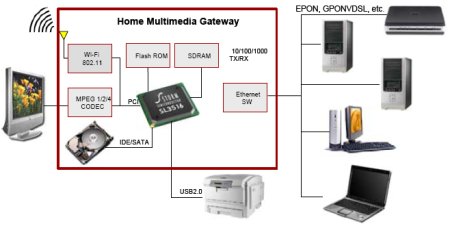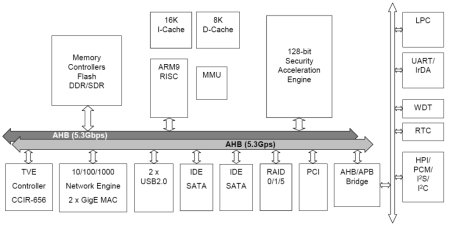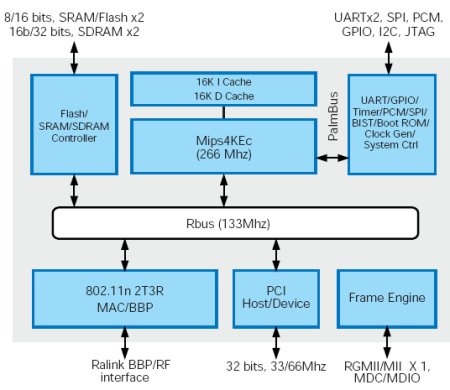Linux design targets 802.11n-enabled homes
Oct 2, 2008 — by Eric Brown — from the LinuxDevices Archive — 13 views Network processor vendor Cortina Systems and WiFi chipset manufacturer Ralink Technology announced a joint hardware/software reference design for WiFi-enabled consumer electronics. Based on Cortina's ARM9-based CS3516 Network Processor and Ralink's 802.11n-compliant RT2880 chipset, the design comes with a Linux board support… package (BSP), says Cortina.
Network processor vendor Cortina Systems and WiFi chipset manufacturer Ralink Technology announced a joint hardware/software reference design for WiFi-enabled consumer electronics. Based on Cortina's ARM9-based CS3516 Network Processor and Ralink's 802.11n-compliant RT2880 chipset, the design comes with a Linux board support… package (BSP), says Cortina.
(Click for larger view of the Ralink RT2880 802.11n SoC, part of the new Cortina/Ralink design)
The unnamed 802.11n reference design is aimed at networked picture frames, internet radios, and networked-attached storage (NAS)-based IP surveillance central stations, says Cortina. The design combines two previously developed reference designs: Cortina's CS3516 Router Gateway NAS reference design kit and Ralink's RT2880 reference design board.
Supporting the high-speed 802.11n draft standard, the combined kit enables 270Mbps aggregate concurrent dual-band throughput, says Cortina. Other touted performance specs include wire-to-wire WAN-to-LAN routing of up to 1Gbps, and 200Mbps wire-to-WiFi performance. The board is also said to support MPEG4, Motion JPEG, and MP3 decoding. The integrated BSP provides system designers with “a unified Linux kernel and application software suite,” says Cortina.

CS3516 in typical home multimedia gateway application
(Click to enlarge)
Cortina, which sells networking and telecom components, and bills itself as addressing the “advanced port processing and intelligent port connectivity” markets, acquired the CS3516 processor when it bought home networking processor firm Storm Semiconductor in June. The CS3516, formerly referred to as the Gemini SL2516, is based on a 32-bit 400MIPS ARM9 processor with a separate embedded MMU and an 8K/16K cache, says Cortina. The SoC supports 256MB of 16-bit 333MHz external DDR SDRAM, as well as “unlimited serial NAND flash,” says the company.

CS3516 block diagram
(Click to enlarge)
The CS3516 design, which provides the foundation for the new 802.11n design, is equipped with a hardware crypto engine, two gigabit Ethernet MACs, dual USB 2.0 hosts or clients, and dual IDE or SATA interfaces, says Cortina. It is also said to offer a 66MHz 32-bit PCI interface, direct interfaces to color LCD and SLIC modules, and a programmable power management unit.
Ralink, meanwhile, is contributing its RT2880 SoC to the design. The 802.11n part is built around the company's 2T3R MAC/BBP, which is said to be a 266MHz MIPS4KEc CPU core. The RT2880 also offers a gigabit Ethernet MAC, a PCI host/device, and two RF companion chips: the RT2820 (2.4G-band) and the RT2850 (dual-band 2.4G or 5G), says Ralink.
The RT2880 chipset can be implemented as either an AP/router or as a WLAN “intelligent” NIC, says Ralink. The latter option is capable of “drastically reducing the load on the host SoC, such as DSL/cable or multimedia applications processors,” says the company.

Ralink RT2880 architecture
(Click to enlarge)
In January, Ralink started sampling two single-chip 802.11b/g/n wireless networking subsystems. The RT3080 targets mobile devices and offers Linux support, while the RT3070 interfaces via USB, and targets PCs, access points, and other devices, Ralink said.
The long-delayed, much debated 802.11n standard boasts as much as twice the range of 802.11g, with better service quality and far greater bandwidth: from 300- to 600Mbps depending on the configuration. To achieve these speeds, 802.11n can use both the 2.4GHz and 5GHz bands, adding technologies such as “channel bonding” — borrowing bandwidth from an adjacent channel — and MIMO (Multiple-In-Multiple-Out) spatial multiplexing, which uses multiple radios and antennas to simultaneously process incoming signals and thereby improve clarity.
Stated Dr. Stewart Wu, Cortina's VP and GM, Digital Home Business Unit, “Consumers are finding new uses for networking in the digital home, such as networked picture frames, internet radio and IP surveillance. OEMs are looking for integrated, high performance solutions.”
Availability
Cortina did not provide availability information on the CS3516/RT2880 802.11n reference design, but the company will join Ralink in demonstrating the design at this week's CEATEC show in Japan.
More information on the CS3516 should be available at this Cortina page. A PDF on the Ralink's RT2880 may be available here.
This article was originally published on LinuxDevices.com and has been donated to the open source community by QuinStreet Inc. Please visit LinuxToday.com for up-to-date news and articles about Linux and open source.